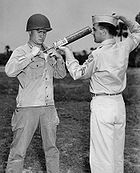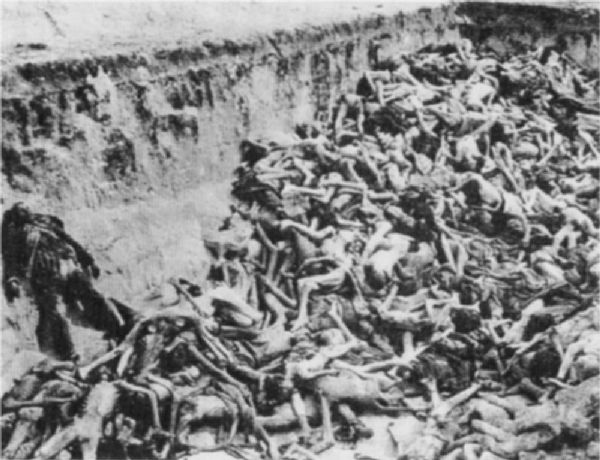 Delousing buildings
Birkenau Sauna
Typhoid
Delousing buildings
Birkenau Sauna
TyphoidTyphus
[back] Holocaust
revisionism
[Typhus was common in prisons (and in crowded conditions where lice spread easily), where it was known as Gaol fever or Jail fever. Gaol fever often occurs when prisoners are frequently huddled together in dark, filthy rooms. Typhus was a real problem in the concentration camps, in the typhus epidemic in the summer of 1942 in the Auschwitz-Birkenau camp from 1 to 19 August, 4,113 deaths were registered, on average 216 per day. This was the main cause of the deaths in Belsen (also Typhoid from contaminated water, and diarrhoea). Typhus victims were stripped after death in order to burn the clothing and destroy the typhus-bearing lice.]
See:
Bedbugs Delousing buildings
Birkenau Sauna
Typhoid
Delousing buildings
Birkenau Sauna
Typhoid
Quotes
All photographs of heaps of corpses were taken in Western camps
around the end of the war, such as Dachau, Bergen-Belsen, and Buchenwald, where
historians now agree no mass murders took place. Significantly, there are
no such photographs taken at the camps in which mass murder is alleged to have
occurred (Auschwitz, Treblinka, Belzec, Sobibor, Chelmno, Majdanek.) These
eastern camps were all in areas which came under Soviet control at war's end. It
is very telling that the Soviets released no pictures of mass graves or heaps of
corpses and allowed no journalists, medical professionals, or other experts to
examine the camps. Since the end of the 1980s.
FAQ about Revisionism
by Germar Rudolf
From November 1941 to September 1942 some 45,000 inmates died in Birkenau, mostly of typhus (cf. J.-C. Pressac, Les Crématoires d'Auschwitz, la Machinerie du meurtre de masse, Paris: CNRS, 1993, pp. 144ff). AIR PHOTO EVIDENCE by JOHN CLIVE BALL
Felderer believed the furnaces at Majdanek to be authentic. (19-4482) The crematory contained an autopsy room and a washroom. (19-4467, 4469) Like Auschwitz, Majdanek also suffered from epidemics of typhus. Felderer was shown the Majdanek death books by a camp official, which indicated that in May of 1942 about 1,500 people had died of the disease. (19-4468) [Ditlieb Felderer] The 'False News' Trial of Ernst Zündel -- 1988
Decomposition of Corpses and Handling of Typhus Infected Corpses:
Lagacé testified that there would be a problem with decomposition if bodies were
left for a period of one to two days. Upon death, the body's defence systems
shut down, leaving any bacteria or viruses in the body "a free rein to wreak
their havoc." There was a rise in the body temperature and gasses began to be
produced. Within hours to a day, bloating caused by tissue gas would cause, for
example, a leg to quadruple in its size. It would be an extremely unpleasant and
dangerous situation if contagious diseases were involved. Tissue gas was highly
contagious and adhered to any equipment such as the floor, the tables, any
instruments used on the bodies. (27-7443, 7444)
Lagacé described the procedures
enforced by the Alberta government in the case of corpses infected with typhus.
At his discretion, the medical officer of health may step in before the body is
even removed from the hospital and specify and order the funeral home to follow
certain procedures in dealing with the body. These included the wearing of
protective clothing when handling the remains, the destruction of that clothing
and the containers that the body was placed in. In a case of typhus, the medical
officer would likely order a direct cremation as this was the most effective way
of dealing with something that volatile. If the body was buried, it had to be
encased in a hermetically sealed container which would last over a prolonged
period of time and only when the soil conditions allowed this, in order to avoid
contamination of the water-table or underground streams. (27-7444, 7445)
[Ivan Lagacé]
The 'False News' Trial of Ernst Zündel -- 1988
"When the (1813 typhus) epidemic came through Leipzig as the army pulled back from the east, Samuel Hahnemann, the founder of homeopathy, was able to treat 180 cases of Typhus-- losing but two. This, at a time when the conventional treatments were having a mortality rate of over 30%....When Cholera finally struck Europe in 1831 the mortality rate (under conventional treatment) was between 40% (Imperial Council of Russia)to 80% (Osler's Practice of Medicine). Out of five people who contracted Cholera, two to four of them died under regular treatment. Dr. Quin, in London, reported the mortality in the ten homeopathic hospitals in 1831-32 as 9%.... In 1854 a Cholera Epidemic struck London. This was a historically important epidemic in that it was the first time the medical community was able to trace the outbreak to a source (a public water pump), and when the pump was closed, the epidemic soon ceased. The House of Commons asked for a report about the various methods of treating the epidemic. When the report was issued, the homeopathic figures were not included. The House of Lords asked for an explanation, and it was admitted that if the homeopathic figures were to be included in the report, it would "skew the results." The suppressed report revealed that under allopathic care the mortality was 59.2% while under homeopathic care the mortality was only 9%."--Julian Winston
That cases of smallpox, of typhus, and of others of the ordinary epidemics, occur in the greatest proportion, in common conditions of foul air from stagnant putrefaction, from bad house drainage from sewers of deposit, from excrement-sodden sites, from filthy street surfaces, from impure water, and from overcrowding in private houses and in public institutions. That the entire removal of such conditions by complete sanitation and by improved dwellings is the effectual preventive of disease of these species, and of ordinary as well as extraordinary epidemic visitations (From an address on "Prevention of Epidemics" delivered by Mr Chadwick at the Brighton Health Congress, 14th Dec. 1881.). [Book 1951] The Truth About Vaccination and Immunization by Lily Loat
One of the most noted epidemiologists, Dr. August Hirsch, maintained that: "Smallpox, as well as typhus, takes up its abode most readily in those places where the noxious influences due to neglected hygiene make themselves most felt." (Handbook of Geographical and Historial Pathology, Vol. 1 p. 481, translated by Dr. Charles Creighton). [Book 1951] The Truth About Vaccination and Immunization by Lily Loat
Many prisons have no water. This defect is frequent in bridewells and town gaols. In the felons' courts of some county gaols there is no water ; in some places where there is water, prisoners are always locked up within doors, and have no more than the keeper or his servants think fit to bring them. In one place they were limited to three pints a-day each—a scanty provision for drink and cleanliness! . . . Some gaols have no sewers, and in those that have, if they be not properly attended to, they are, even to a visitant, offensive beyond expression. How noxious, then, to people constantly confined in those prisons!" Under these conditions, is it to be wondered at, that typhus and small-pox prevailed to the "destruction of multitudes "? A Century of Vaccination and What it Teaches. London: Swan Sonnenschein & Co, 1898 by W. Scott Tebb
"Rife showed that by altering the
environment and food supply, friendly bacteria such as colon bacillus could be
converted into varied "pathogenic" bacteria. For example, Rife also observed
that bacillus coli could in time be modified into the bacterial agent associated
with typhus, and the process actually reversed. In Rife's words:
"In reality, it is not the bacteria themselves that
produce the disease, but we believe it is . . . the unbalanced cell metabolism
of the human body that in actuality produce the of disease. We also believe if
the metabolism of the human body is perfectly balanced . . . it is susceptible
to no disease."
This observation closely parallels
Alexis Carrel's earlier research at the Rockefeller Institute where he was able
to control the rates and levels of infectious disease mortality among mice.
Beginning with the standard diet he observed a corresponding death rate of 52
percent. By making specific dietary improvements he was able to reduce mortality
rates downward to 32 percent, then 14 percent, and finally to a rate of 0.45
"----"----Dr. Raymond Obomsawin
"I have myself, through Natural Hygiene, over 16 years, treated all forms and hundreds of cases of typhus and typhoid fevers, pneumonia's, measles and dysentery's, and have not lost a single patient. The same is true of scarlet and other fevers. No medicine whatever was given."----Dr Trall, 1862.
Buchenwald was a
Class II concentration camp for political prisoners, who were mainly Communists.
It was not a death camp where Jews were brought to be systematically killed.
Buchenwald was for hard-core anti-Fascists who were considered more dangerous to
the German state than the political prisoners sent to Dachau or Sachsenhausen,
which were both designated as Class I camps.
General Patton also mentioned that
Buchenwald had "a number of allegedly eminent physicians" who were performing
"some very abominable experiments on their fellow inmates."
The only medical experiment that Patton cited as an example was one in
which 800 prisoners in the camp were "inoculated with anti-typhus vaccine and
then inoculated with the typhus bug." The vaccine was a failure, and 700 out
of the 800 died of typhus.
America had a typhus vaccine and
all the American soldiers had been vaccinated before going overseas. According
to the March 1945 issue of the Red Cross monthly bulletin, American soldiers
held as POWs in German camps were given booster shots of typhus vaccine, which
was delivered by the Red Cross and distributed by the Germans. Since this
vaccine was only given to Americans, the Germans were working to develop their
own vaccine for the rest of the prisoners and for the German Army.
General Patton's observation that
the camp was run by the "slaves" was basically correct. When the camp was
originally opened, the Nazis brought common criminals from the Sachsenhausen
camp near Berlin to run the camp internally. But after the first Commandant,
Karl Otto Koch, was relieved of his duties and sent to Majdanek, the new
Commandant, Hermann Pister, allowed the Communists to take over.
Buchenwald Survivors